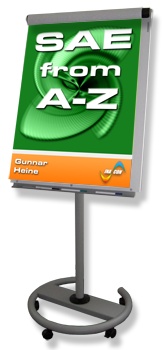 SAE / EPC from A-Z
SAE / EPC from A-Z
[2-day course, Euro 2,350.- (net) per participant]
 Training Course Description
Training Course Description

- This training course describes in detail the network architecture of the evolved packet core network (EPC) and it discusses migration strategies and implementation options.
- Starting out with an assessment of why an architecture evolution is necessary in the first place, the training course outlines the most important targets of a system architecture evolution from the perspective of the 3GPP.
- The training course continues with the detailed evaluation and description of the different new network elements like the MME, S-GW, PDN-GW and ePDG.
- This includes the detailed discussion of such important implementation aspects like S1Flex and how it can be applied under different circumstances.
- The following part provides an overview over all kinds of EPC-related scenarios like attachment from 3GPP- and non-3GPP-specific radio access technologies, host and network based mobility and call setup under different conditions.
- Another section deals with the network layout and introduces new concepts like the tracking area and the new types of TMSI's.
- In great detail the training course describes such important aspects like the QoS-architecture and the security architecture of Rel. 8 and how it blends into the EPC.
- One complete chapter has been dedicated to the introductory description of the various protocols that are used within the EPC-environment. This includes all EPC- and E-UTRAN-specific protocols like RRC or S1-AP but it also includes introductions into DIAMETER, IPv6, QoS in IP or SCTP.
- The final chapter has been dedicated to the presentation of the important EPC-related procedures like attachment from E-UTRAN, tracking area updating, dedicated EPS-bearer establishment and handover.
As in all INACON training courses we integrated several interactive exercises for a perfect learning experience.
Please click here for a detailed Table of Contents (ToC)
 Some of your questions that will be answered
Some of your questions that will be answered
- Why is there a system architecture evolution in the first place?
- What are the requirements according to 3GPP?
- How will the protocol architecture of a typical UE look like within the SAE-environment?
- Which potential improvements have not been covered yet by the SAE?
- How do the network access and attachment work for the different RAT's?
- What is SRVCC and how does it operate?
- How does the UE prioritize different available access networks and access network types?
- How does a UE which is attached to the EPC, establish a voice call?
- How does inter-RAT mobility work while the UE is attached to the EPC?
- What are the most important differences between host and network based mobility?
- What are tracking areas and what is their relationship to location areas and routing areas?
- Which new identifiers are used within the evolved core network environment to identify users?
- How does the QoS-architecture look like in the evolved network?
- Why are security procedures like encryption and integrity protection provided twice for some content in the EPS-environment?
- What is S1-Flex and how does it operate?
- How do the e2e-protocol stacks look like within the SAE-environment?
- Which tasks do EMM and ESM take care of and how do EMM and ESM compare and relate to GMM and SM?
- How does a UE attach to the EPC through E-UTRAN and how does it establish the default EPS-bearer and how are dedicated EPS-bearers established?
- How is handover performed in E-UTRAN?
 Who should attend this class?
Who should attend this class?
- Test engineers who need to understand the EPS-architecture and its new concepts in detail.
- Design staff of EPC network elements who require a deep inside view of the new architecture and protocols.
- Everybody who shall be able to respond to sophisticated EPS-related questions.
 Pre-Requisites
Pre-Requisites
- The student must possess a thorough understanding in mobile communication before coming to this training course.
- At the least we recommend our webinars or web based training courses on SAE and LTE to be taken beforehand.
 Training Course Target
Training Course Target
- The student is enabled to develop, test and integrate EPC-related networks.
 Training Course Duration
Training Course Duration
- 2 days
v2.2
ℹ️ Try out the updated search below!
Search:
More Info:
Detailed ToC of this training course
Schedule of this training course
Buy this book
INACON eBooks
Please have a look at our full offer

